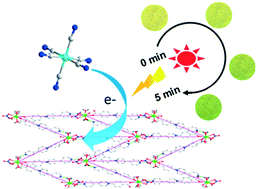Photochromic and photocontrolled luminescent rare-earth D–A hybrid crystals based on rigid viologen acceptors†
Abstract
As an emerging class of hybrid complexes, the donor–acceptor (D–A) hybrid crystals containing photoactive organic and inorganic components have gradually become an ideal platform for constructing photochromic materials in recent years. In order to investigate the effect of D–A interactions on photochromic properties, three novel hybrid crystals, [Eu2(NO3)2(cbp-I)4(H2O)8][Co(CN)6](NO3)·6H2O·CH3OH (1), [Eu(NO3)2(cbp-I)2(H2O)3](NO3)·3H2O (2), and (cbp-II)(cbp-III)[Co(CN)6]·7H2O (3), have been designed and synthesized. They all exhibit reversible eye-detectable color changes with different photoresponsive speeds: the photoresponse speeds are 1 > 3 > 2. This result can be attributed to the introduction of effective electron-transfer channels through combining [Co(CN)6]3− as an electron donor with viologen acceptors in 1 and 3, in comparison to 2. Moreover, accompanied with the interesting photochromic process, these unique hybrid compounds simultaneously possess a photomodulated luminescent behaviour. The luminescent intensity of 2 is far greater than that of the other two compounds, and 2 shows high sensitivity towards 4-nitroaniline with a very small LOD of ca. 9.78 × 10−7 M.

- This article is part of the themed collection: Supramolecular & Polymorphism


 Please wait while we load your content...
Please wait while we load your content...